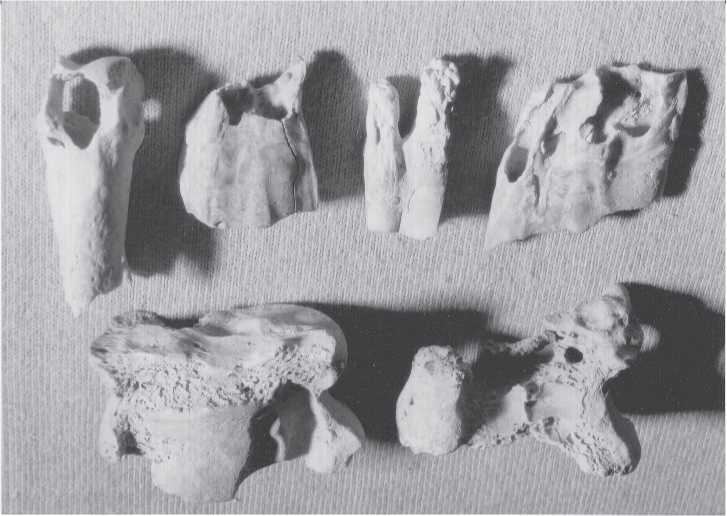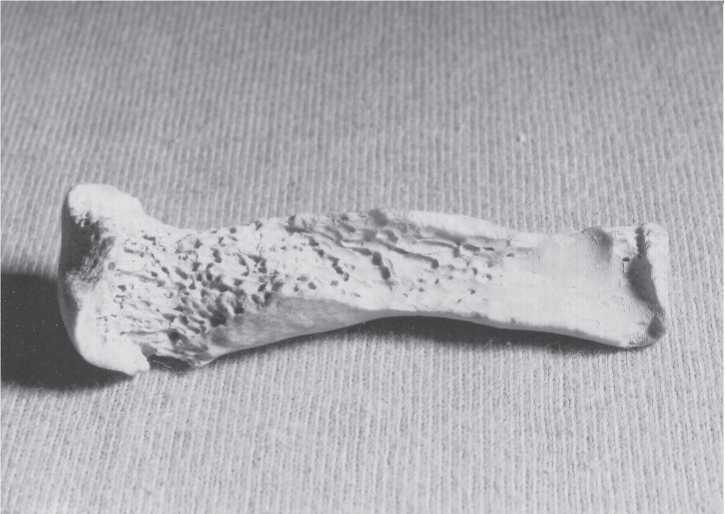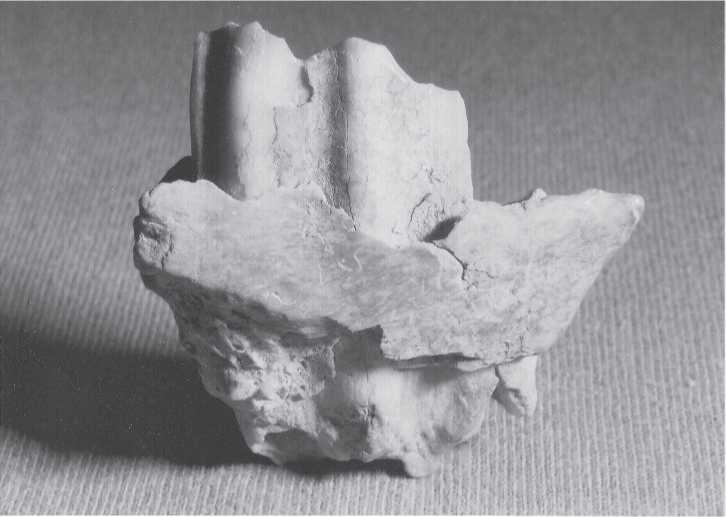1 Provenience. Cave deposits discussed above.
2 Species. Of the 178 pieces we examined, Capra (55.1%), hyena (9.5%), goat-sheep (8.4%), fox (7.9%), horse (4.5%), and wolf (3.9%) are the most commonly represented species (Table A1.2, site 16). With the exception of goat-sheep and horse, these species occur more frequently in Maly Yaloman than in the pooled assemblage. Although yak is represented by only 2.2% of the 178 pieces, Maly Yaloman and Kaminnaya (0.3%) are nevertheless the only two of our 30 assemblages where this species has been recognized in this study or previous studies.
3 Skeletal elements. Our sample of 178 pieces contained most of the skeletal elements listed in Table A1.3 (site 16). Not represented are the cranial base, hyoid, femur, fibula, epiphysis, and penis bone. Most common are the mandible, teeth, foot, and toe bones. Compared with the averages in the pooled assemblage, Maly Yaloman is unexceptional for the occurrence of most skeletal elements. Only the mandible, teeth, foot, and toe bones occur in greater numbers, and unknown pieces are less common than the averages of the pooled assemblage.
4 Age. Adults make up 75.3% of our 178 pieces (Table A1.4, site 16). This value is greater than the 63.0% adults in the pooled assemblage, although sub-adults and unknowns are nearly the same. Although hyena remains were found in Maly Yaloman, the degree of destructiveness for age determination is about half that of Razboinich’ya.
5 Completeness. Our 178 pieces are about two-thirds incomplete - that is, one anatomical end (28.1%) and no anatomical ends (39.3%) (Table A1.5, site 16). These values are similar to the averages in the pooled assemblage. Maly Yaloman has more whole bones (32.6%) than does Razboinich’ya (8.6%).
6 Maximum size. While the mean maximum size (4.9 cm) of the 177 Maly Yaloman pieces is less than that of the pooled assemblage, the two sets of ranges are nearly the same. There is essentially no difference in size statistics between Maly Yaloman and Razboinich’ya (Table A1.6, site 16). Comparing the whole long bone lengths of sheep-goat, hyena, and fox provided by Vera Gromova (1950: table 27) shows that the Maly Yaloman upper range limit (28.1 cm) is very similar to that of sheep-goat, very slightly larger than that of hyena, and much larger than that of fox.
7 Damage shape. The most common form of damage includes long bone fragments (13.5%) and tooth-bearing skull parts (10.7%). Undamaged bones (14.6%) and mostly whole bones (14.6%) were the most common of the damage categories (Table A1.7, site 16). Compared with the pooled assemblage, Maly Yaloman tooth-bearing parts, undamaged bones, and mostly whole bones are more common. Long bone fragments are less common. Compared with Razboinich’ ya, Maly Yaloman underwent much less damage.
8 Color. Most (96.1%) of the 178 Maly Yaloman pieces are ivory in color, with only 3.9% being brown (Table A1.8, site 16). There are no black pieces. These values are greater for ivory, and less for brown compared with the pooled assemblage. They are similar to the color frequencies of Razboinich’ ya.
9 Preservation. Quality of preservation is quite high in the 178 pieces of the Maly Yaloman assemblage (Table A1.9, site 16). Ivory (96.6%) pieces far outnumber chalky (1.7%) or intermediate (1.7%) conditions. The pooled assemblage has less ivory and more chalky representation. Razboinich’ya is much like Maly Yaloman.
10 Perimortem breakage. Three-quarters (74.7%) of the 178 Maly Yaloman pieces exhibit perimortem breakage (Table A1.10, site 16). This is somewhat less than what turns up in the pooled assemblage (84.4%), even more so compared with Razboinich’ya (92.4%).
11 Postmortem breakage. There is very little postmortem breakage in the Maly Yaloman assemblage (178 pieces, 4.5%) (Table A1.11, site 16). This is about the same as the average for the pooled assemblage, and less than what occurs in Razboinich’ya. This hints at the possibility that hyenas introduced less surface-scavenged bone into Maly Yaloman that at Razboinich’ ya.
12 End-hollowing. Only 116 pieces could be assessed for end-hollowing (Table A1.12, site 16). It was found in 9.5% of the set, the value of which is almost identical with the average for the pooled assemblage and nearly the same as found at Razboinich’ya.
13 Notching. All 178 Maly Yaloman pieces could be assessed for notching (Table A1.13, site 16). Nearly one-quarter (23.0%) had notching. Of these, the most fTequent number of notches per piece was one (10.1%), three (5.1%), and two (4.5%). There is more notching in the Maly Yaloman assemblage than in the pooled assemblage average, but almost exactly the same amount (23.6%) as found in Razboinich’ya.
14 Tooth scratches. Of 175 Maly Yaloman pieces, 28.6% exhibittooth scratching (Table A1.14, site 16). These occur in roughly the same frequency from one to more than seven scratches per piece. There is a higher frequency of scratches in Maly Yaloman than in the average of the pooled assemblage (20.6%), but less than in Razboinich’ya (37.1%).
15 Tooth dints. As above, we have 175 pieces, of which 32.6% have tooth dints (Table A1.15, site 16). This is more than the average for the pooled assemblage. The most frequent number of dints in Maly Yaloman is more than seven (10.2%). Razboinich’ya has more pieces with tooth dints (52.8%).
16 Pseudo-cuts. A total of 6.3% of 174 pieces have pseudo-cuts (Table Al.16, site 16). The most frequent number per piece is one (2.3%). The occurrence of Maly Yaloman pseudo-cut pieces is nearly like the average for the pooled assemblage. Razboinich’ya has fewer pieces with pseudo-cuts (3.1%).
17 Abrasions. Abrasions occurred in only 1.2% of 173 Maly Yaloman pieces (Table A1.17, site 16). This is almost identical to the pooled assemblage average, and only slightly more than was found in Razboinich’ya (0.5%).
18 Polishing. PolishingisverycommoninMalyYaloman, therebeing89.3%in 178pieces (Table A1.18, site 16). Polishing occurs on the end (12.9%), middle (1.1%), and both end and middle sections (75.3%). Compared with the pooled assemblage average, Maly Yaloman has about three times more polished pieces. It has more than was found at Razboinich’ya (59.4%).
19 Embedded fragments. This feature could be assessed in 177 Maly Yaloman pieces (Table A1.19, site 16). A total of 2.3% had embedded fragments. This is less than the pooled assemblage average. It is about three times less than occurs in Razboinich’ya (8.8%).
20 Tooth wear. Tooth wear was scored in 34 Maly Yaloman pieces (Table A1.20, site
16). Of these, 11.8% were judged to be young individuals. This is much less than the pooled assemblage average and Razboinich’ya (36.0%).
21 Acid erosion (Figs. 3.85-3.86). Nearly half (48.0%) of 177 Maly Yaloman pieces are acid eroded (Table A1.21, site 16). This is many times more frequent than the pooled assemblage average and the value obtained for Razboinich’ya (7.3%). Even had no hyena skeletal elements been found in Maly Yaloman, the very high frequency of acid erosion (the highest in our entire study) would still signal considerable use of the cave by hyenas.

Fig. 3.85 Maly Yaloman hyena digestive damage. Pieces of Capra teeth, toes, astragalus, and uncertain
Skeletal element that had been partly dissolved by hyena gut secretions (CGT neg. IAE 8-5-03:22).

Fig. 3.86 Maly Yaloman hyena digestive damage. Capra phalanx, 5.2 cm in length (CGT neg. IAE 8-5-03:17).

Fig. 3.87 Maly Yaloman bone damage. Capra mandible fragment with chewing and polishing, even on roots.
Maximum diameter is 4.6 cm (CGT neg. IAE 8-5-03:15).
22-23 Rodent gnawing and insect damage. No signs of either form of damage were found.
24 Human bone. A human tooth was reportedly found, but lost sometime before our study.
25 Cut marks. Of 174 Maly Yaloman pieces, 2.3% have cut marks (Table A1.25, site 16). This is less than the pooled assemblage average. Razboinich’ya has no cut marks. One Maly Yaloman piece has about 200 very fine cut marks. One central portion of a yak pelvis recovered in 1988 that Ovodov had stored in his Krasnoyarsk apartment, which we examined in August 2006 and therefore not included in the sample discussed herein, had heavy chewing damage on the remaining mesial and distal ends and very fine cut marks near the acetabular region. The authors were unable to identify the sequence of human and carnivore damage to this yak pelvis because no superpositioning of cuts and tooth scratches could be recognized.
26 Chop marks. Chopping is very rare (0.6%) in our 174 Maly Yaloman pieces (Table A1.26, site 16). This rare occurrence is less than the pooled assemblage average. As with cut marks, Razboinich’ya has no chopped pieces.




 World History
World History









